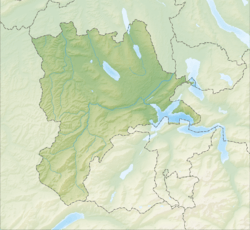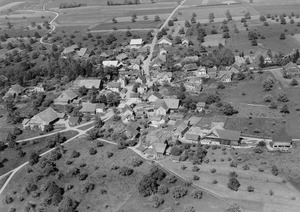Müswangen facts for kids
Quick facts for kids
Müswangen
|
||
|---|---|---|
|
||
| Country | Switzerland | |
| Canton | Lucerne | |
| District | Hochdorf | |
| Area | ||
| • Total | 4.50 km2 (1.74 sq mi) | |
| Elevation | 783 m (2,569 ft) | |
| Population | ||
| • Total | 453 | |
| • Density | 100.67/km2 (260.7/sq mi) | |
| Postal code |
6289
|
|
| Surrounded by | Beinwil (Freiamt) (AG), Buttwil (AG), Geltwil (AG), Hämikon, Schongau, Sulz | |
Müswangen was a small town, also called a municipality, in Switzerland. It was located in the canton of Lucerne, within the Hochdorf district. On January 1, 2009, Müswangen became part of a larger municipality called Hitzkirch.
Contents
History of Müswangen
Müswangen is a very old place. The first time it was ever written about was in the year 924. Back then, it was known by a slightly different name: Milizwaga.
Geography and Land Use
Müswangen covers an area of about 4.5 square kilometers (which is about 1.7 square miles). A big part of this land, about 70.9%, is used for farming. This means there are many fields and farms. Forests cover about 24.2% of the area. The remaining land, about 4.7%, has buildings and roads.
The municipality is located on the western side of a mountain called Lindenberg.
Joining Other Towns
In 2006, there was an idea to combine Hitzkirch with 10 other nearby towns, including Müswangen. However, this plan didn't work out because five of the eleven towns voted against it.
Later, a new plan was made. This time, a smaller group of towns agreed to join Hitzkirch. On January 1, 2009, Müswangen, along with Gelfingen, Hämikon, Mosen, Retschwil, and Sulz, officially became part of the Hitzkirch municipality.
People and Life in Müswangen
In 2007, Müswangen had a population of 453 people. About 4.6% of these people were from other countries. Over the ten years before 2007, the population grew by about 4.1%.
Languages Spoken
Most people in Müswangen speak German. In 2000, about 95.7% of the population spoke German. The second most common language was Albanian, spoken by 2.3% of the people. French was the third most common, spoken by 1.8%.
Politics and Voting
When people voted in the 2007 election, the most popular political group was the SVP. They received 30.2% of the votes. Other popular groups included the FDP (28.9%), the CVP (26.5%), and the Green Party (6.8%). These parties represent different ideas about how the government should work.
Age and Education
In 2000, children and teenagers (ages 0-19) made up 34.6% of the population. Adults (ages 20-64) were 56.7%, and seniors (over 64) were 8.7%.
Most people in Switzerland are well-educated. In Müswangen, about 71.9% of adults between 25 and 64 years old had finished high school or gone on to higher education, like a university.
Work and Jobs
Müswangen had a very low unemployment rate of 1.05%. This means almost everyone who wanted a job had one.
In 2005, many people worked in farming. There were 61 people working in the primary economic sector (like farming) and 24 businesses in this area. The secondary sector (which includes things like manufacturing) employed 17 people across 5 businesses. The tertiary sector (which includes services like shops or offices) had 36 people working in 10 businesses.
Population Changes Over Time
The number of people living in Müswangen has changed quite a bit over the years. Here's a look at the historical population:
| Year | Population |
|---|---|
| 1798 | 307 |
| 1850 | 442 |
| 1900 | 324 |
| 1950 | 259 |
| 1980 | 217 |
| 2000 | 439 |





